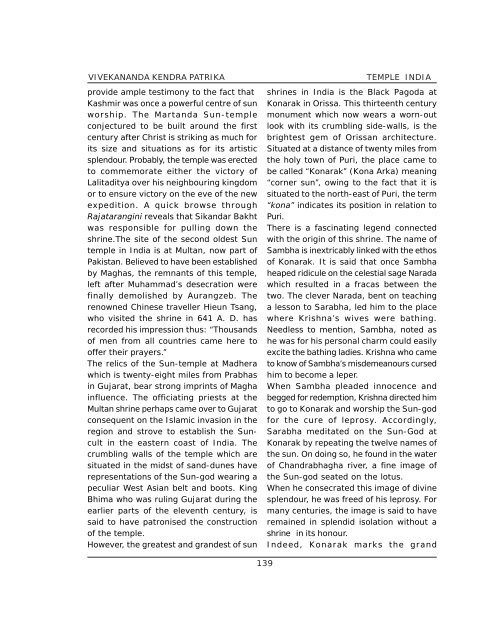Temples In India-1.pdf - Vivekananda Kendra Prakashan
Temples In India-1.pdf - Vivekananda Kendra Prakashan
Temples In India-1.pdf - Vivekananda Kendra Prakashan
Create successful ePaper yourself
Turn your PDF publications into a flip-book with our unique Google optimized e-Paper software.
VIVEKANANDA KENDRA PATRIKAprovide ample testimony to the fact thatKashmir was once a powerful centre of sunworship. The Martanda Sun-templeconjectured to be built around the firstcentury after Christ is striking as much forits size and situations as for its artisticsplendour. Probably, the temple was erectedto commemorate either the victory ofLalitaditya over his neighbouring kingdomor to ensure victory on the eve of the newexpedition. A quick browse throughRajatarangini reveals that Sikandar Bakhtwas responsible for pulling down theshrine.The site of the second oldest Suntemple in <strong>In</strong>dia is at Multan, now part ofPakistan. Believed to have been establishedby Maghas, the remnants of this temple,left after Muhammad’s desecration werefinally demolished by Aurangzeb. Therenowned Chinese traveller Hieun Tsang,who visited the shrine in 641 A. D. hasrecorded his impression thus: “Thousandsof men from all countries came here tooffer their prayers.”The relics of the Sun-temple at Madherawhich is twenty-eight miles from Prabhasin Gujarat, bear strong imprints of Maghainfluence. The officiating priests at theMultan shrine perhaps came over to Gujaratconsequent on the Islamic invasion in theregion and strove to establish the Suncultin the eastern coast of <strong>In</strong>dia. Thecrumbling walls of the temple which aresituated in the midst of sand-dunes haverepresentations of the Sun-god wearing apeculiar West Asian belt and boots. KingBhima who was ruling Gujarat during theearlier parts of the eleventh century, issaid to have patronised the constructionof the temple.However, the greatest and grandest of sunTEMPLE INDIAshrines in <strong>In</strong>dia is the Black Pagoda atKonarak in Orissa. This thirteenth centurymonument which now wears a worn-outlook with its crumbling side-walls, is thebrightest gem of Orissan architecture.Situated at a distance of twenty miles fromthe holy town of Puri, the place came tobe called “Konarak” (Kona Arka) meaning“corner sun”, owing to the fact that it issituated to the north-east of Puri, the term“kona” indicates its position in relation toPuri.There is a fascinating legend connectedwith the origin of this shrine. The name ofSambha is inextricably linked with the ethosof Konarak. It is said that once Sambhaheaped ridicule on the celestial sage Naradawhich resulted in a fracas between thetwo. The clever Narada, bent on teachinga lesson to Sarabha, led him to the placewhere Krishna’s wives were bathing.Needless to mention, Sambha, noted ashe was for his personal charm could easilyexcite the bathing ladies. Krishna who cameto know of Sambha’s misdemeanours cursedhim to become a leper.When Sambha pleaded innocence andbegged for redemption, Krishna directed himto go to Konarak and worship the Sun-godfor the cure of leprosy. Accordingly,Sarabha meditated on the Sun-God atKonarak by repeating the twelve names ofthe sun. On doing so, he found in the waterof Chandrabhagha river, a fine image ofthe Sun-god seated on the lotus.When he consecrated this image of divinesplendour, he was freed of his leprosy. Formany centuries, the image is said to haveremained in splendid isolation without ashrine in its honour.<strong>In</strong>deed, Konarak marks the grand139
















